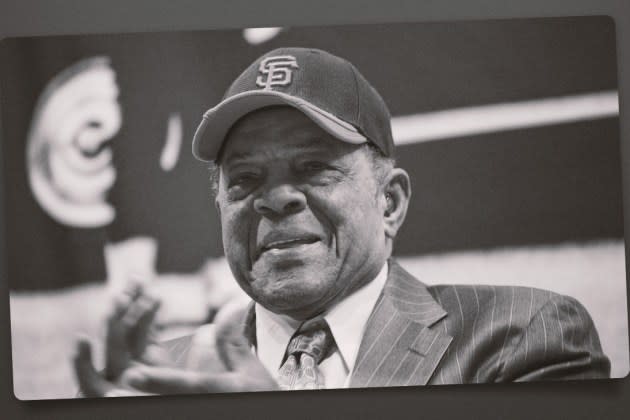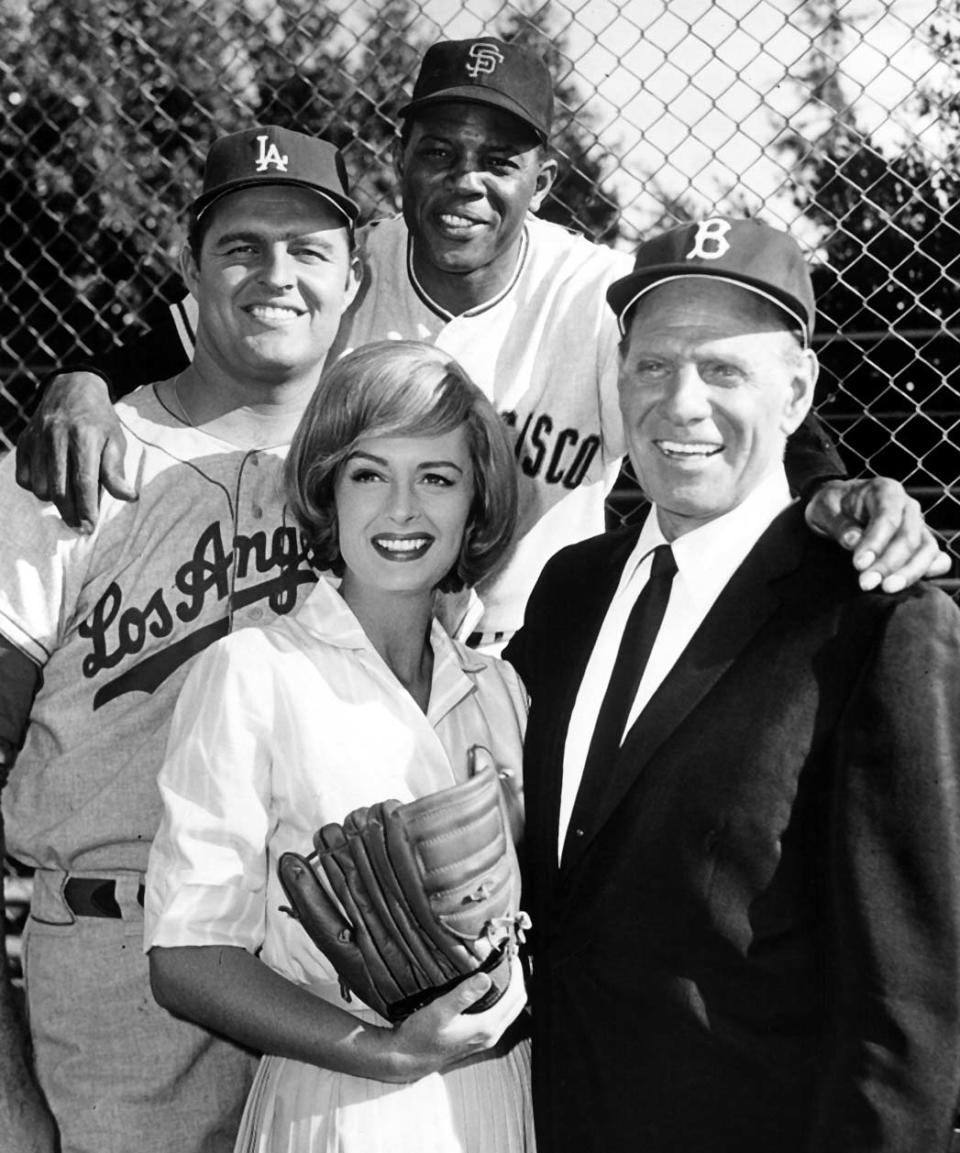Willie Mays, Entertaining Icon of Baseball, Dies at 93

Willie Mays, the incandescent center fielder for the New York and San Francisco Giants whose unmatched blend of speed and power made him a cultural icon and one of the finest players in the history of baseball, died Tuesday. He was 93.
“It is with great sadness that we announce that San Francisco Giants Legend and Hall of Famer Willie Mays passed away peacefully this afternoon at the age of 93,” the San Francisco Giants shared on its official X (formerly Twitter) account.
More from The Hollywood Reporter
Where to Stream 'Federer: Twelve Final Days' Online for Free
Anouk Aimée, Enigmatic Star of 'A Man and a Woman,' 'La Dolce Vita' and '8 1/2,' Dies at 92
Hiram Kasten, New York Comedy Club Staple and TV Actor, Dies at 71
A day before his death, Mays said that he would not be in attendance when the Giants face the St. Louis Cardinals at Rickwood Field in Alabama on Thursday in a game honoring him and the Negro Leagues (he began his baseball career with the Birmingham Black Barons of the Negro Leagues).
“I’m not able to get to Birmingham this year but will follow the game back here in the Bay Area,” he told the San Francisco Chronicle in a statement on Monday. “My heart will be with all of you who are honoring the Negro League ballplayers, who should always be remembered, including all my teammates on the Black Barons. I wanted to thank Major League Baseball, the Giants, the Cardinals and all the fans who’ll be at Rickwood or watching the game. It’ll be a special day, and I hope the kids will enjoy it and be inspired by it.”
Inducted into the National Baseball Hall of Fame on his first try in 1979, Mays finished his 22-year MLB career with 660 home runs, the third most (behind only Hank Aaron and Babe Ruth) at the time of his retirement. (He since has been passed by his godson, Barry Bonds, Alex Rodriguez and Albert Pujols.) The Alabama native also collected 3,283 hits, good for 11th on the all-time list. (These stats were subject to an MLB decision to elevate Negro League baseball, where Mays got his start, to “major league” status.)
An aerodynamic 5-foot-11 and 180 pounds in his prime, Mays also led the National League in stolen bases four times and was acrobatic in the outfield. One of his plays, accomplished at the cavernous Polo Grounds in Manhattan during the 1954 World Series, ranks among the most jaw-dropping the game has ever seen.
A two-time NL Most Valuable Player and 24-time All-Star, “The Say Hey Kid” came to the major leagues as a 20-year-old with the Giants. He moved to San Francisco with the team in 1958, then returned to the Big Apple midway through the 1972 season when he was traded to the New York Mets.
In 1999, ESPN placed him No. 8 on its list of the 100 greatest athletes of the 20th century, trailing only Michael Jordan, Ruth, Muhammad Ali, Jim Brown, Wayne Gretzky, Jesse Owens and Jim Thorpe.
“If somebody came up and hit .450, stole 100 bases and performed a miracle in the field every day, I’d still look you right in the eye and tell you that Willie was better,” Leo Durocher, his manager with the New York Giants, wrote in his 1975 book, Nice Guys Finish Last. “He could do the five things you have to do to be a superstar: hit, hit with power, run, throw and field. And he had the other magic ingredient that turns a superstar into a super-superstar. Charisma.”
Mays always considered himself an entertainer. “When I played ball, I tried to make sure that everybody enjoyed what I was doing,” he said in James S. Hirsch’s 2010 authorized biography Willie Mays: The Life, the Legend. “I made the clubhouse guy fit me a cap so that when I ran, the wind gets up in the bottom and it flies right off. People love that type of stuff.”
As far as real show business goes, Mays appeared with Dean Martin and Jerry Lewis on the Colgate Comedy Hour in 1954, on two episodes of The Donna Reed Show in 1964 and on other comedies like Bewitched — could warlock-like powers be the real source of his tremendous abilities? — My Two Dads and Mr. Belvedere.

Wesley Snipes and Omar Epps, respectively, played a speedster by the name of Willie Mays Hayes in Major League (1989) and its 1994 sequel.
Mays also can be heard on the 1954 tune “Say Hey (The Willie Mays Song),” recorded by The Treniers (Quincy Jones served as the musical director on the recording session), and he received shout-outs from John Fogerty on “Centerfield” and Chuck D. on “The Amazing Willie Mays.”
In the 2022 HBO documentary Say Hey, Willie Mays, directed by Nelson George, longtime Giants broadcaster Jon Miller said he didn’t think of Mays “as a mere ballplayer or even as a human being as I look back on it, but rather as a superhero.
“Willie Mays walks down the street and fathers say to their sons, ‘There goes Willie Mays, the greatest player to ever play this game.'”
Willie Howard Mays was born on May 6, 1931, in Westfield, Alabama, a town outside Birmingham. His father, Willie Howard Mays Sr., was a mill worker nicknamed “Cat” for his quickness on the baseball field. His mother, Annie, excelled at track and basketball in high school.
The Boston Braves began scouting Mays when he was 15 and still a student at Fairfield Industrial High School. (Imagine that: Mays could have played in the same Braves outfield as Aaron.) At 16, he joined Birmingham, then was signed by the Giants in 1950 for $4,000 (the Barons got $10,000) and assigned to a minor-league club in Trenton, New Jersey.
In 1951, Mays was hitting .477 for the Triple-A Minneapolis Millers when he was called up to New York on May 25, 1951. A couple of weeks past his 20th birthday, he was the youngest black player to ever reach the majors. (Jackie Robinson had broken baseball’s color barrier just four years earlier.)
After starting his MLB career 0-for-12 and 1-for-26 — his lone hit was a home run off Warren Spahn of the Braves at the Polo Grounds — Mays went on to hit .274 with 20 home runs in 121 games and was named the NL’s Rookie of the Year.
That remarkable season also saw the Giants erase a 13 1/2-game deficit to tie Brooklyn at the end of the regular season, and Mays was on deck when Bobby Thomson homered off the Dodgers’ Ralph Branca in the bottom of the ninth inning in the last game of a three-game playoff series.
The blow (“The Giants win the pennant! The Giants win the pennant! The Giants win the pennant!” howled play-by-play man Russ Hodges) sent Mays and his jubilant teammates into the World Series against the New York Yankees, though they would lose in six games.
Mays was drafted into the U.S. Army and appeared in just 34 games during the 1952 season and missed all of 1953, but he returned in ’54 and led the league with a .345 batting average and 13 triples while belting 41 homers. The Giants then swept the Cleveland Indians as Mays claimed the only World Series championship of his career.
In the eighth inning of Game 1 with the score tied, none out and two men on, Cleveland slugger Vic Wertz sent a towering drive 440 feet away from home plate. Mays, playing shallow, ran full speed to make an over-the-shoulder catch, then spun and fired the ball back to the infield. (And yes, he lost his cap.)
“There was no doubt I was going to catch the ball,” Mays insisted. He said the throw was the most impressive part of the play.
He carried the Giants to the World Series again in 1962, but they lost in seven games to the Yankees.
At age 41, Mays came back to New York to play for the Mets, a team created in 1962 in the wake of the Giants and Dodgers fleeing to the West Coast. Journeyman Jim Beauchamp gave up his No. 24 so Mays could keep the number that he made famous, and the legend helped New York make it to the World Series against the Oakland Athletics in 1973, his final season.
Mays, perhaps too old to play center field, slipped while trying to catch a fly ball in the sun in Game 2, and the Mets fell in seven games.
“By the time he retired,” Hirsch wrote, Mays “was an American icon whose athletic brilliance and stylistic bravado contributed to the assimilation of Blacks during the turbulent civil rights era, a distinctive figure of ambition, sacrifice and triumph who became a lasting cultural touchstone for a nation in search of heroes.”
In 1980, Mays was unfathomably banned from baseball after he was hired as an ambassador for an Atlantic City casino but was reinstated by then-MLB commissioner Peter Ueberroth in 1985. Thirty years later, he received the Presidential Medal of Freedom from Barack Obama.
Mays had served as special assistant to the president of the San Francisco Giants since 1986. Oracle Park, home of the Giants, is located at 24 Willie Mays Plaza and features a larger-than-life statue of him in front of the main entrance.
He founded the Say Hey Foundation in 2000 to assist underprivileged youth. In addition to Bonds, survivors include his son, Michael.
“I never had a day when somebody would not come up to me and say, ‘I saw you make a play, I love you because of what you did for me,” Mays said in the HBO documentary. “It made me very very proud because not only did I play baseball, but the people enjoyed what I did.”
Best of The Hollywood Reporter

 Yahoo Sport
Yahoo Sport 






































